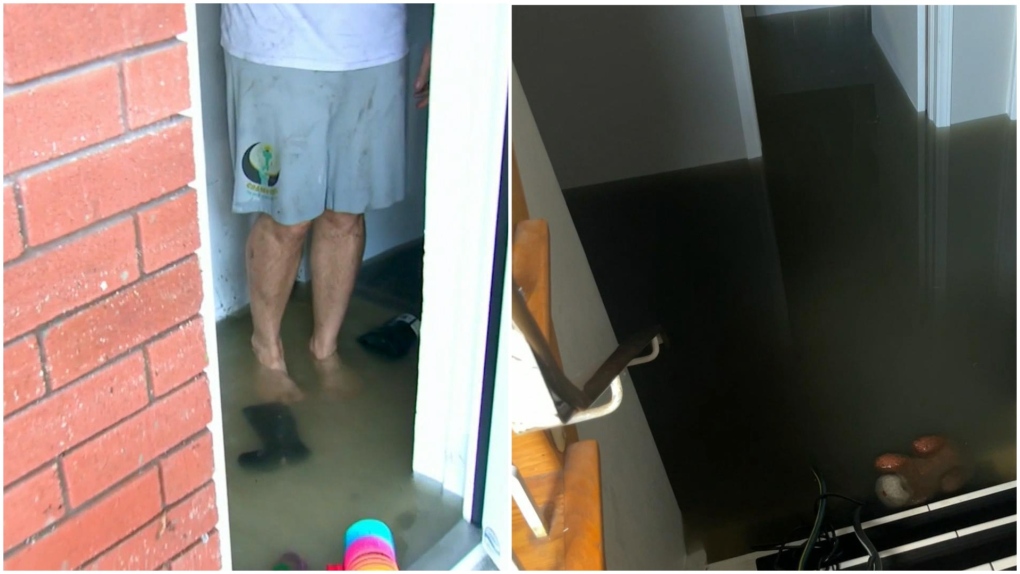Toronto is still drying out after a storm dropped more than a month’s worth of rain on the city earlier this week, leaving some residents to deal with flooded basements and property damage left in its wake.
“I was literally shocked,” Karma Kunsang, a resident of the Rockcliffe–Smythe neighbourhood in Toronto’s northwest, told CTV News Toronto.
The area was particularly hit hard by Tuesday’s rainfall and the water levels in Kunsang’s basement reached knee-high height, destroying furniture and toppling over large appliances as the storm surged.
“This place, it was like a movie. When this happens to your own house, your brain stops working,” he said.
Eric Swanson lives nearby and saw at least a foot of water in his home’s lower level, despite installing a pressure-sealing door and powered backwater valve in the basement.
“Do we call insurance? Do we not call insurance? The mould and the disgustingness of the water and all those issues…I need to get this properly cleaned and taken care of so that my house is still livable,” Swanson said.
Homes weren’t the only things damaged in the record-breaking storm, which saw nearly 100 millimetres of rainfall in just a few hours. Several vehicles were also abandoned by their drivers after water gushed onto major roadways across the city, including the Don Valley Parkway where 14 people needed to be rescued.
The torrential downpour is already being compared to Toronto’s 2013 storm – listed as one of the most expensive natural disasters in Canada, according to insurance payouts. Data from the Insurance Bureau of Canada (IBC) shows that claims filed in the aftermath of that weather event reached $1 billion.
 The basements of Eric Swanson (left) and Karma Kunsang (right) were flooded following Tuesday’s record-breaking storm in Toronto.
The basements of Eric Swanson (left) and Karma Kunsang (right) were flooded following Tuesday’s record-breaking storm in Toronto.
While it’s too early to put a dollar figure on the damage left it the aftermath of Tuesday’s storm, the IBC told CTV News Toronto that the two events are “similar.”
“We can’t determine, at this point, what the magnitude of this event is,” Anne Marie Thomas, IBC’s director of consumer and industry relations, said. “We can’t say what this event will cost because, as you can imagine, not everyone has filed an insurance claim yet.”
Insurance tips for flooded house, car
If your basement was flooded or you needed to abandon your vehicle, the first thing you should do is reach out to you insurer or insurance broker to check your coverage.
“Not all [insurance] policies have coverage for weather events like this one,” Thomas said, adding that sewer backup coverage and overland flood coverage would be needed in the case of home insurance, both of which are optional and not always included in basic policies.
“A typical homeowner’s insurance policy doesn’t cover damage caused by sewer backup or flood. It only covers [damage] caused by a burst pipe or something like that in your home,” she said.
After you’ve determined what type of coverage you have, the next step is making an inventory of all the damaged items, including taking pictures and videos of those items. If you have proof of purchase, such as a receipt, for an item you’re looking to make a claim for, that will assist in the process.
One important note is to hold on to any damaged items before you dispose of them, because, as Thomas explains, the insurance adjuster will want to see the damage as it was at the time of the event.
“So if your house is damaged, and you go, ‘OK, I’m just gonna get rid of this.’ Wait until your insurance company says it’s okay. Unless that item is posing a health hazard or is a danger,” she said.
As well, if you rented any equipment to dry out your home, such as a shop vac or industrial fan, keep those receipts as you could be reimbursed.
In terms of vehicle insurance for owners who were forced to ditch their vehicle amid the flooding, much like home insurance, only certain policies will cover the damage.
“In order for those vehicles to be covered by insurance, the owner of the vehicle would have to have purchased collision or comprehensive coverage or ‘all perils’ coverage,” Thomas said. “Those are the optional physical damage coverages that you can buy for your car. If you have that, then your insurance company would pay to either fix the vehicle or write off your vehicle.”
Typically, following a storm like the one on Tuesday, Thomas said the full “realization” of the damage isn’t known until 30 to 45 days after the event.
 Cars are partially submerged in flood waters in the Don Valley following heavy rain in Toronto, on Tuesday, July 16 2024. THE CANADIAN PRESS/Arlyn McAdorey
Cars are partially submerged in flood waters in the Don Valley following heavy rain in Toronto, on Tuesday, July 16 2024. THE CANADIAN PRESS/Arlyn McAdorey